Housing-Autonomous car
Contents
1. Housing problems
1) Causes of housing problems
a. The rise of house prices and the lack of housing provision due to rapid urbanization
· Urbanization as a product of industrialization
- The UK and many other developed countries urbanized during the 18th and 19th centuries.
- Due to the mechanization in farming people migrated from rural area to urban areas where there was employment in the new factories.
- The city areas (inner city) developed during this time as rows of terraced housing were built for workers.
- Lack of affordable housing, transport congestion, over-rapid growth and environmental degradation etc.
- articularly, sharp inequalities in housing provision, employment, education and service were displayed in the inner-city areas → Urbanization is taking place rapidly particularly in developing countries.
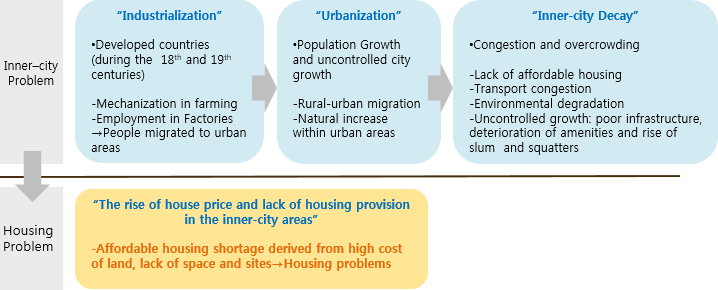
b. Social and demographic change: greater demand for housing
· Extension of human life span
· Rise in the number of smaller households such as single-parent and single-person households and immigrant households
2) Solution to housing problems

a. Promoting counter-urbanization through the commercialization of self-driving car →Solving housing provision issue
· Promoting counter-urbanization with the commercialization of self-driving car.
- Reduced driving stress with self-driving function allows users to commute long distance.
· Autonomous vehicle technology application at electric vehicle promotes the commercialization of self-driving car.
- Reduction of noise and vibration with electric vehicle technology enables users to travel long distance without stress. That promotes counter-urbanization.
…Solving the electric car’s battery problem with self-driving vehicle technology
…Amplifying the synergy with merging benefits of autonomous cars and electric vehicles promotes the commercialization of self-driving car.
b. Self-driving motorhome(recreational vehicle or camping car)provision → Satisfying small house demand
· Electric vehicle technology application at self-driving motorhomes.
- Reduced driving and parking stress
- Motorhomes offering living accommodation can perform a small housing role
c. Changing perception for real estate
· Real estate recognized as the asset with high volatility
- As usual, real estate is considered as more secure than other assets such as gold or stock due to low market volatility.
- With the proliferation of autonomous vehicles and small motor homes(mobile home), the functional regionalization of land and urban space will be changed rapidly, furthermore, the real estate will be recognized as assets with high volatility such as stocks.
- As property bubbles fall, housing prices keep falling and being stabled.
2. Self-driving Car
1) Self-driving Car
Self-Driving Car (Driverless Car, Autonomous Car, Robot Car) : ICT+ Car
· Advanced cars equipped with autonomous driving system
· ICT revolution replaces drivers with computer systems: Self driving cars are capable of sensing its environment and navigating without human input.
Autonomous car
2) Product commercialization
a. Leading self-driving car Manufacturers
· Google, Intel, GM, Mercedes Benz, Audi, Nissan, Apple, BMW, Volvo, Rio Tinto
b. Predictions
· 75 percent of the road will be self driving cars by 2040 (data from The Institute of Electrical and Electronics Engineers)
· In September 2022, the Ministry of Land, Infrastructure and Transport announced a 'Mobility innovation road map': Level 3[Conditional Driving Automation] vehicles launch in 2022
· Level 4[High Driving Automation] buses and shuttles launch by 2025: The Ministry of Land, Infrastructure and Transport plans to develop Level 4 buses and shuttles by 2025 and launch the commercial operation of autonomous public transportation service by 2027.
"5년내 완전자율주행차 상용화" ...택시,버스 등 대중교통 부터
3) Potential impacts on daily living
a. Increased safety and efficiency
· Reduction in traffic accident by 90%
· Reduction in wasted commute time and energy by 90%
· Reduction in the number of cars by 90%
b. Free time : reduced driving stress
c. Parking: once people arrives at destination and hop out at the front door and leave the car to slink sway and wait for people to summon it later with their smartphone.
d. Congestion: Self-driving cars can travel in convoys, inches apart, without any needless dabs of the brake pedals to filter backwards through traffic and create mysterious, pointless hold-ups.
e. Highway : After solving congestion problem, people doesn’t need to create larger roads any more
f. Mobility for non-drivers
· School run: Driver’s license doesn’t need any more. Children can drive themselves.
※ Great mileage - Some benefits of the driverless car (Sources: Google, US NHTSA,AAA, Texas A&M Transportation Institute, Columbia University Earth Institute and Devil’s Advocate Group’s analysis)
…Solving the electric car’s battery problem with self-driving vehicle technology
…Amplifying the synergy with merging benefits of autonomous cars and electric vehicles promotes the commercialization of self-driving car.
- Motorhomes offering living accommodation can perform a small housing role
- With the proliferation of autonomous vehicles and small motor homes(mobile home), the functional regionalization of land and urban space will be changed rapidly, furthermore, the real estate will be recognized as assets with high volatility such as stocks.
- As property bubbles fall, housing prices keep falling and being stabled.
· ICT revolution replaces drivers with computer systems: Self driving cars are capable of sensing its environment and navigating without human input.
· In September 2022, the Ministry of Land, Infrastructure and Transport announced a 'Mobility innovation road map': Level 3[Conditional Driving Automation] vehicles launch in 2022
· Level 4[High Driving Automation] buses and shuttles launch by 2025: The Ministry of Land, Infrastructure and Transport plans to develop Level 4 buses and shuttles by 2025 and launch the commercial operation of autonomous public transportation service by 2027.
· Reduction in wasted commute time and energy by 90%
· Reduction in the number of cars by 90%
| Google’s Aspiration | Potential annual Benefits (US only) | 2009 (US only) |
|---|---|---|
| 90%reduction in accidents |
- 4.95million fewer accidents
|
- 5.5million motor vehicle accidents
|
| 90%reduction wasted commuting |
- 4.8billion fewer commuting hours
|
- A study estimated that traffic congestion wasted 4.8billion hours and 1.9 billion gallons of fuel a year for urban Americans. |
| 90%reduction in cars |
- Reduced cost per trip-mile by 80% or more
|
4) Not a car
a. Reduced the stress from long distance driving enables users to commute and travel long distance →Promoting counter-urbanization →Solving the housing problem
· Long distance commuting is available with self-driving cars
· Reduced inconvenience of suburbs survival
b. Changing perception for urbanization
· Global urban-dwelling population: 3.5billion
· 2000~2010, the increase in American urban population: 12%
· Changing perception of long distance: Self-driving cars will make travel more bearable or enjoyable
· People can expect suburban areas to sprawl out from cities, and rural communities to thrive.
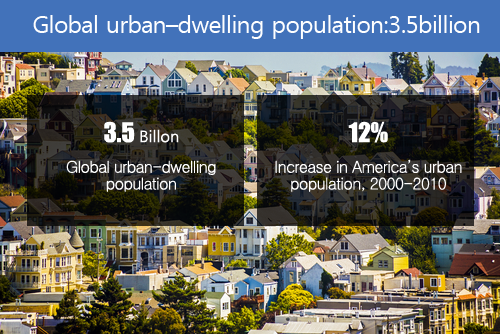
c. Reduced inconveniences from living in the suburbs
· Non-drivers living in the suburbs without good transit don’t need to move into downtown for inconvenience
Why Self-Driving Cars Will Change Retirementd. Car bundled with house
· Self-driving cars will be designed to match the house and have a seamless look
· Regarded as a part of house
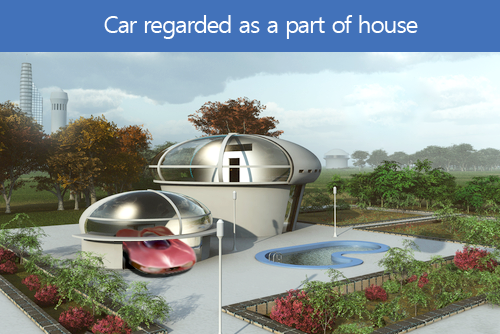
e. Competitiveness of auto: car interior design and amenities
· Promoting car interior design and amenities rather than its speed, mileage and exterior: It is derived from the customer needs for spending some quality time doing the things they want while traveling and commuting
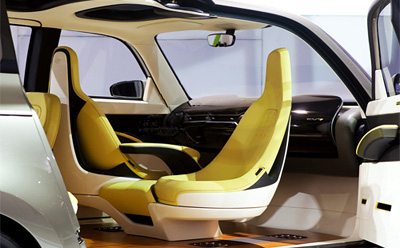
Trend : Fully electric Benz F105 Luxury in Motion concept car presented at CES 2015
Merchedes’s self-driving car is evolved to ‘living room on the street’: ultimately become a mobile living space and the third space for retreating, working and playing (Dieter Zetsche, Chairman of Daimler-Benz AG at the CES2015)
The Mercedes-Benz F015 Luxury in Motion
Merchedes’s self-driving car is evolved to ‘living room on the street’: ultimately become a mobile living space and the third space for retreating, working and playing (Dieter Zetsche, Chairman of Daimler-Benz AG at the CES2015)
The Mercedes-Benz F015 Luxury in Motion
3. Electric vehicle
1) Electric vehicle - An Automobile that is propelled by electric motor
· Using electrical energy stored in batteries or another energy storage device
· No harmful tailpipe emissions
· Perfect noise and vibration control
2) Battery technology - The electric car’s biggest problem is it’s battery
· Credit-Suisse suggest that the price of lithium-ion could fall by2020
· Global battery prices are expected to continue to drop, enabling electric vehicles to reach parity with internal combustion engines by 2024, according to a new report from research firm Bloomberg NEF.
· The report, BNEF’s 2019 Battery Price Survey, forecasts that average battery prices will be close to $100 per kilowatt hour (kWh) by 2023, compared with a 2019 price of $156/kWh. The report noted that 2019 battery prices have fallen 87% since 2010 when they were $1,100/kWh.
· Cheaper batteries will encourage consumers to purchase electric cars.
Battery price drops driving EVs to parity by 2024 : BNEFBattery technology charges ahead
3) Governmental support
Governmental policy initiatives to encourage the electric vehicle supply and infrastructure expansion
· U.S.: American Clean Energy and Security Act of 2009
- President Obama set the goal for the U.S. to become the first country to have 1million electric vehicles on the road by 2015
- Over 100 free electric charging stations along the highway: people can move from eastern united states to western with electric vehicle for free
- Free vehicle charging benefits to 98%of electric vehicle buyer by the end of 2015
· China: Electric vehicle supply plan
- 1million electric vehicles on the road by 2015, and 5 million by 2020
· EU : Actively participate in infrastructure expansion
4) Autonomous vehicle technology application
a. Autonomous vehicle technology application at electric vehicle
· Evolving from electric vehicles, a large gadget running on electricity into the all-computer powered car by Google, Apple or MS.
· Solving electric vehicle’s battery charging problem through wireless charging technology
· Encouraging the supply of self-driving vehicles
· The ultimate green move will be combining two emerging technologies: autonomous driving and fully electric cars. Autonomy brings efficiency in driving and battery use, while electric cars drastically cut emissions, fuel costs and maintenance.
Why the Cars of our Self-Driving Future Will Be Electric
b. Google & Tesla
· Google was already interested in exploring pairing autonomous cars with electric cars.
· Google and Tesla were collaborating on some kind of tech around electric vehicle (EV) and autonomous cars.
5) Promoting the commercialization of self-driving car
a. Tranquil means of transportation without noise and vibration
· It allows users to commute long distance.
b. Encouraging the commercialization of autonomous vehicle.
· Autonomous vehicle technology application at electric vehicle solves electric vehicle’s battery charging problem.
· Contribution to promoting counter-urbanization →Solving housing provision issue
4. Motorhomes(Recreational Vehicle or Camping Car)
1) Motorhomes
a. A type of recreational vehicle equipped with living accommodation for long journey/h4>
· Motorhomes can be roughly classified into three categories according to their equipment and price: Class A, Class B, and Class C
· A Class A motorhome has a reputation for being the most luxurious and expensive vehicles. Usually it used for enjoying leisure life or long journey by campers or retirees.
Motorhome
b. Barriers to motorhomes proliferation
· No plan for mass production → Expensive vehicle
· Increased driving stress→ Long and big vehicle size
· Inconvenient to park→ Parking is limited to the camping grounds. Unsuitable for road environment
· A Class A motorhome has a reputation for being the most luxurious and expensive vehicles. Usually it used for enjoying leisure life or long journey by campers or retirees.
· Increased driving stress→ Long and big vehicle size
· Inconvenient to park→ Parking is limited to the camping grounds. Unsuitable for road environment
· Reduced driving and parking stress
· Performing a small housing role as well as long journey and camping
3) Small housing provision
a. Affordable and small housing provision
· Increased demand for small houses derived from the social and demographic change, such as extension of human life span, rise in the number of smaller households
· Affordable and small houses required for solving inner-city problems.
· Pairing autonomous vehicle technology with motor homes equipped with living accommodation can perform a small housing role
· Autonomous driving seems to be the future of motoring, and Germany's Erwin Hymer Group, a powerhouse in the motorhome industry, has the Galileo concept to imagine what an RV might be like when a steering wheel is no longer a necessary feature. It's a tiny apartment going down the highway.
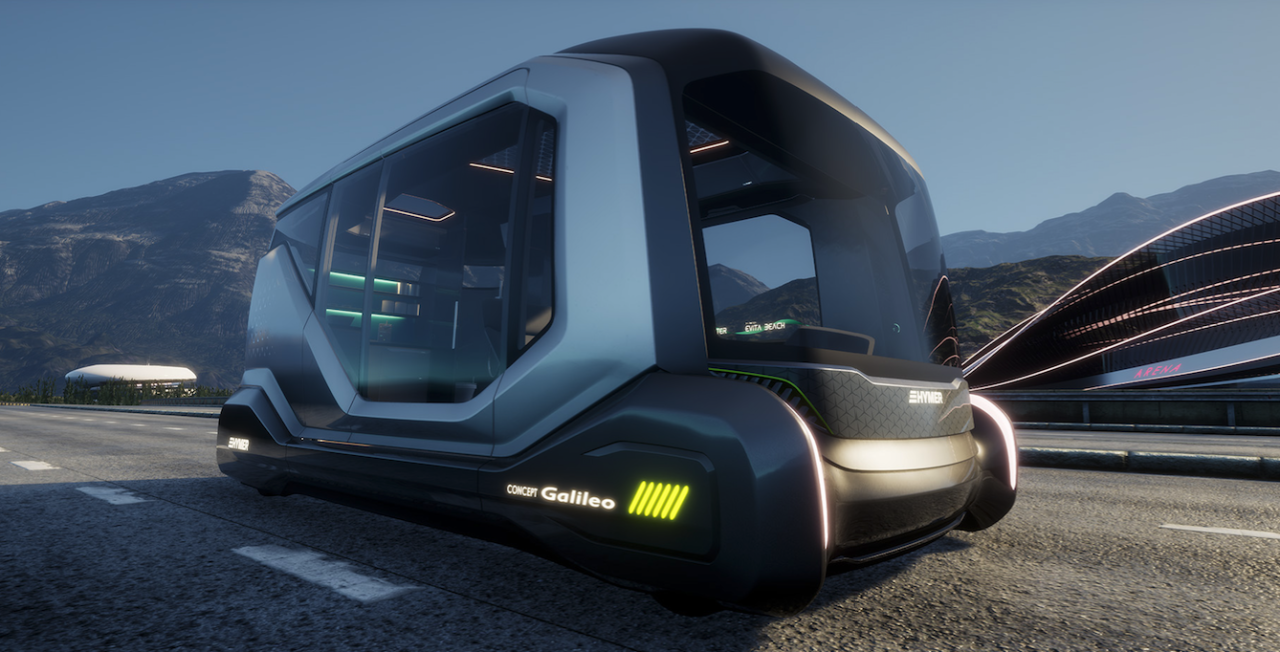 Hymer Galileo Concept Envisions Driverless Tiny House On Wheels
Hymer Galileo Concept Envisions Driverless Tiny House On Wheels
b. Nomadic Trend & Vanlife
· The nomadic trend has been on the rise since the financial collapse in 2008
· The solution to the Bay Area housing crisis
· Van life as an attitude, not a vehicle
· The van life movement has also spawned travelogue-style YouTube channels and DIY forums where people seek advice about things like how to get mail on the road
Van life: My 80-square-foot solution to the Bay Area housing crisis
5. Solution to housing problems
| Housing problem |
1. "Housing provision problem" derived from the rise of house prices in the inner-city areas· Urbanization and inner-city decay → Lack of affordable housing, transport congestion, environmental degradation and inequalities in service benefits (employment, education and etc)2. "Increased demand for smaller housing"· Social and Demographic Change → Rise in the number of smaller households |
|---|---|
| Solution |
Solving housing problems with self-driving car and self-driving motorhomes 1) Promoting counter-urbanization through the commercialization of self-driving cars Commercialization of self-driving car
· Reduced driving and travelling stress allows users to commute long distance
Driverless technology application at electric vehicle promotes the commercialization of self-driving cars |

